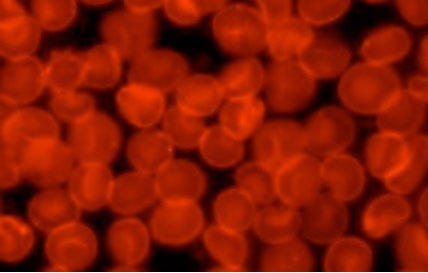July 3, 2014
In research that may one day lead to a whole range of diagnostics and therapies, scientists at the Whitehead Institute for Biomedical Research have genetically and enzymatically modified red blood cells (RBCs) to carry a range of valuable payloads -- from drugs, to vaccines, to imaging agents - that can be transported throughout the circulatory system to a specific site in the body.
In addition to being the most numerous cells in the body, mature RBCs have the distinction of lacking a nucleus and all the DNA contained therein. Reasoning that this characteristic might be exploited, Harvey F. Lodish, PhD, and his lab introduced genes that coded for specific slightly modified normal red cell surface proteins into early-stage RBC progenitors.
|
Human red blood cells on a glass slide (Courtesy Whitehead Institute for Biomedical Research) |
"We wanted to create high-value red cells that do more than simply carry oxygen," says Whitehead Founding Member Lodish. He collaborated with Whitehead Member Hidde Ploegh, PhD, who developed the biochemical methods in his lab.
The result of the team's work, "Engineered Red Blood Cells as Carriers for Systemic Delivery of a Wide Array of Functional Probes" (Shi, et al.), is published in the Proceedings of the National Academy of Sciences.
"Here we've laid out the technology to make mouse and human red blood cells in culture that can express what we want and potentially be used for therapeutic or diagnostic purposes," Lodish said.
Ploegh refers to his protein-labeling technique as "sortagging." His approach uses the bacterial enzyme sortase A to establish a strong chemical bond between the surface protein and a substance of choice. That substance could be a small-molecule therapeutic or an antibody capable of binding a toxin. The modifications leave the cells and their surfaces unharmed.
"Because the modified human red blood cells can circulate in the body for up to four months, one could envision a scenario in which the cells are used to introduce antibodies that neutralize a toxin," says Ploegh. "The result would be long-lasting reserves of antitoxin antibodies."
The approach has captured the attention of the U.S. military and its Defense Advanced Research Projects Agency (DARPA), which is supporting the research at Whitehead in the interest of developing treatments or vaccines effective against biological weapons.
Lodish believes the applications are potentially vast. They may include RBCs modified to bind and remove bad cholesterol from the bloodstream, carry clot-busting proteins to treat ischemic strokes or deep-vein thrombosis, or deliver anti-inflammatory antibodies to alleviate chronic inflammation.
Refresh your medical device industry knowledge at MEDevice San Diego, September 10-11, 2014. |
Ploegh notes that there is evidence to suggest that modified RBCs could be used to suppress the immune response that often accompanies treatment with protein-based therapies and is exploring whether the modified RBCs could be used to prime the immune system to allow patients to better tolerate treatment with such therapies.
Stephen Levy is a contributor to Qmed and MPMN.
Like what you're reading? Subscribe to our daily e-newsletter.
About the Author(s)
You May Also Like



